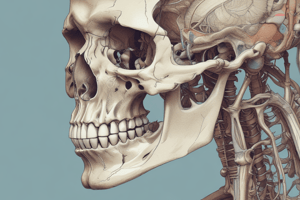Podcast
Questions and Answers
Which type of bone primarily aids in weight support and facilitates movement?
Which type of bone primarily aids in weight support and facilitates movement?
- Irregular Bones
- Flat Bones
- Short Bones
- Long Bones (correct)
What is the primary function of flat bones?
What is the primary function of flat bones?
- Support weight and allow for movement
- Protect internal organs and offer muscle attachment (correct)
- Provide flexibility and support organs
- Facilitate blood cell production
Which part of the long bone contains spongy bone and red marrow?
Which part of the long bone contains spongy bone and red marrow?
- Metaphysis
- Diaphysis
- Periosteum
- Epiphysis (correct)
What type of joint is characterized as being immovable?
What type of joint is characterized as being immovable?
Which structure envelops bones except at the surfaces of joints?
Which structure envelops bones except at the surfaces of joints?
What function does the axial skeleton serve?
What function does the axial skeleton serve?
What is the main role of inorganic components in bone composition?
What is the main role of inorganic components in bone composition?
Which process describes the continuous cycle of bone resorption and formation?
Which process describes the continuous cycle of bone resorption and formation?
Flashcards are hidden until you start studying
Study Notes
Anatomy of the Skeletal System
-
Overview
- The skeletal system provides structure, support, and protection to the body.
- Composed of bones, cartilage, ligaments, and joints.
-
Types of Bones
- Long Bones
- Examples: Femur, humerus.
- Function: Support weight and facilitate movement.
- Short Bones
- Examples: Carpals, tarsals.
- Function: Provide stability and support with little movement.
- Flat Bones
- Examples: Sternum, ribs, skull.
- Function: Protect internal organs and provide surface area for muscle attachment.
- Irregular Bones
- Examples: Vertebrae, pelvis.
- Function: Support and protect organs while allowing for flexibility.
- Long Bones
-
Bone Structure
- Diaphysis: The shaft of long bones, primarily composed of compact bone.
- Epiphysis: The end part of long bones, containing spongy bone and red marrow.
- Metaphysis: The region between diaphysis and epiphysis, where growth occurs in children.
- Articular Cartilage: Covers ends of bones at joints to reduce friction.
- Periosteum: A dense layer of vascular connective tissue enveloping the bones except at surfaces of joints.
-
Bone Composition
- Organic Components: Collagen fibers and cells (osteoblasts, osteocytes, osteoclasts).
- Inorganic Components: Minerals (mainly calcium phosphate) that provide hardness.
-
Joint Types
- Fibrous Joints: Immovable joints (e.g., skull sutures).
- Cartilaginous Joints: Slightly movable (e.g., intervertebral discs).
- Synovial Joints: Freely movable and most common type (e.g., knee, hip).
-
Skeletal Categories
- Axial Skeleton: Consists of 80 bones including the skull, vertebral column, and rib cage.
- Appendicular Skeleton: Comprises 126 bones including the limbs and girdles.
-
Functions of the Skeletal System
- Provides shape and support.
- Protects vital organs (e.g., brain, heart).
- Facilitates movement by serving as levers for muscles.
- Stores minerals (e.g., calcium, phosphorus).
- Produces blood cells in bone marrow (hematopoiesis).
-
Bone Remodeling
- The ongoing process of bone resorption and formation.
- Influenced by mechanical stress, hormonal changes, and nutritional factors.
Overview of the Skeletal System
- Provides structure, support, and protection for the body.
- Composed of bones, cartilage, ligaments, and joints.
Types of Bones
-
Long Bones
- Examples: Femur, humerus.
- Function: Support body weight and facilitate movement.
-
Short Bones
- Examples: Carpals, tarsals.
- Function: Provide stability and support with minimal movement.
-
Flat Bones
- Examples: Sternum, ribs, skull.
- Function: Protect internal organs and provide surface area for muscle attachment.
-
Irregular Bones
- Examples: Vertebrae, pelvis.
- Function: Support and protect organs while allowing flexibility.
Bone Structure
- Diaphysis: Shaft of long bones, primarily made of compact bone.
- Epiphysis: End part of long bones with spongy bone and red marrow.
- Metaphysis: Growth region between diaphysis and epiphysis in children.
- Articular Cartilage: Covers endings of bones at joints to reduce friction.
- Periosteum: Vascular connective tissue surrounding bones, excluding joint surfaces.
Bone Composition
- Organic Components: Include collagen fibers and bone cells (osteoblasts, osteocytes, osteoclasts).
- Inorganic Components: Mainly minerals like calcium phosphate, which confer hardness to bones.
Joint Types
- Fibrous Joints: Immovable (e.g., skull sutures).
- Cartilaginous Joints: Slightly movable (e.g., intervertebral discs).
- Synovial Joints: Freely movable and most common (e.g., knee, hip).
Skeletal Categories
- Axial Skeleton: 80 bones including skull, vertebral column, and rib cage.
- Appendicular Skeleton: 126 bones comprising limbs and girdles.
Functions of the Skeletal System
- Provides shape and structural support.
- Protects vital organs like the brain and heart.
- Facilitates movement as levers for muscles.
- Stores minerals such as calcium and phosphorus.
- Produces blood cells in bone marrow (hematopoiesis).
Bone Remodeling
- Continuous process involving bone resorption and formation.
- Influenced by mechanical stress, hormonal changes, and nutritional factors.
Studying That Suits You
Use AI to generate personalized quizzes and flashcards to suit your learning preferences.




